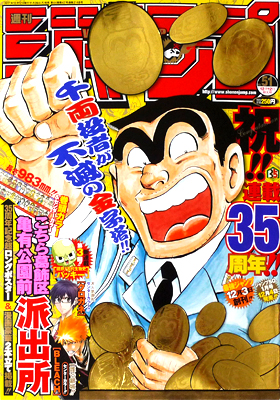Every once in a while, I take a look at the various shonen magazines out there and see what is already licensed, likely to be licensed, and highly unlikely to be licensed. The shonen market can be vicious, and now that Kodansha is mostly back to normal over here, and Viz is where it’s always been, I want to take a look at their two magazines and see where we are today, and where we could be in the future.
(Look, I apologize to Shonen Sunday fans, but… no. It’s a mug’s game. Viz will probably license Silver Spoon when it get enough volumes. That’s all I got. I wish it sold better.)
I’ll start with Magazine, which has a slightly broader variety of content, though it also panders more towards the older teen/younger man who likes breasts and panties more than Jump does. (Arguably Jump panders more to the yaoi fangirl lately as well, but that’s a highly controversial topic, and it’s easy to see their core titles as still all being for young teen boys.)
Magazine’s final issue of 2011 (pictured above) has 24 stories in it. Five of those are licensed in some way or another: Air Gear, Negima, Fairy Tail, Bloody Monday (the current series is the ‘Final (3rd) Season’, Kodansha has licensed the first so far), and Cage of Eden. Another series which is on break this issue is also licensed: Sayonara, Zetsubou-sensei. And a 7th series was licensed by Del Rey but is currently in that limbo state of “It’s not cancelled, we’re just never releasing any more of it”: Code:Breaker. Lastly, Vertical has licensed the recently finished Onizuka manga, GTO: Shonan 14 Days.
That leaves a lot of stuff in the current magazine that’s never hit North American shores. (And yes, there are other options as well: popular series now finished but still unlicensed, like Yankee-kun to Megane-chan, and other ‘licensed by Del Rey but probably cancelled’ old series such as Suzuka and School Rumble. But I’m looking at the current magazine.)
First, there are the brand new, just started series that are too new to get a handle on. These include Star Children, which debuts in this issue, and seems to be about an astronaut school. Tanteiken Sherdock is about the reincarnation of Sherlock Holmes as a cute small dog, and is from the author of cult favorite Psychometrer Eiji. Lastly, there’s Dragon Collection: Ryuu o Suberumono, which is apparently based on a video game, and honestly might have the best chance to get picked up of this whole lot, especially if Deltora Quest does well.
Then there are the gag manga, most of which never get licensed over here as the humor frequently never translates well, is very ‘Osaka-style’, and has art styles that are best described as stylized (i.e., they are unpretty). Sayonara, Zetsubou-sensei is an exception to this, but then it also has more pages and more of a plot than most gag manga. (Well, pseudo-plot.) Zeus no Tane, Namiuchigiwa no Muromi-san, and Mou, Shimasen Kara have very little chance of making it to these shores. There’s also Seitokai Yakuindomo, which has an anime to its name. However, it has another major killer: it’s an entire manga about sex jokes. If you like seeing young high school girls make jokes about their hymens and the male lead’s penis every single page, then it’s perfect for you. Otherwise, I’m fairly sure Kodansha is happy to leave it as a Japanese phenomenon.
There are also a large number of sports manga, many of which have multiple volumes, and almost all of which are unlikely to appear here. Daiya no A (baseball), Ahiru no Sora (basketball), Area no Kishi (soccer), and Baby Steps (tennis). I’ll also throw Gamaran in here, which is in the Edo period, but still is unlikely to be licensed as it’s a martial arts manga with fighting on almost every page. Lastly, we have Hajime no Ippo, which deserves special mention as it’s not only a boxing manga but also has so many volumes that Dallas Middaugh would have a heart attack just trying to schedule it.
Now we have the rest of the magazine. A-Bout is a delinquents series, and I’ve discussed the popularity of these in Japan as opposed to America before. Kimi to Iru Machi is a romantic comedy from the author of Suzuka. If Suzuka didn’t sell here (and they tried – it had fancy oversize volumes and everything) why try something by the same artist? AKB49 – Renai Kinshi Jourei is the sort of thing that might get licensed if it were shoujo (it’s about celebrity singers, it features a guy cross-dressing as a girl, etc.) – but it’s not shoujo. It’s also a tie-in to real life idol singers, and thus might be too ‘Japan-specific’. There is GE – Good Ending, another romantic comedy/drama. Shonen romantic comedies don’t sell anymore, as their fans tend to read them online and them complain about each chapter being the ‘last one they’ll ever read’ a lot. This one also apparently has one of those casts that makes you want to kill everyone in it with fire. Lastly, we have Tobaku Haouden Rei: Gyankihen. First off, gambling is a uniquely popular Japanese shonen genre that really hasn’t taken off here. Second, it has Pointy Chin Syndrome, and its faces are simply too ‘interesting’ to be licensed. Third, it’s a sequel.
So, really, I think we’re good with Magazine titles for the moment. Kodansha and Vertical might agree with me, seeing as their new licenses came from the Magazine spinoffs instead.
Jump this week has twenty-one series in it, eight of which have been licensed: One Piece, Naruto, Bleach, Bakuman, Toriko, Nura: Rise of the Yokai Clan, Reborn!, and Hunter x Hunter. There’s also Gintama, which is still running in Japan but has been cancelled here. (Of note: Bleach has been incredibly unpopular in Japan recently. After the end of the ‘Aizen’ arc, it plummeted to the bottom of Jump’s TOC (which is partly based on a reader poll), and with one or two exceptions has remained there since. I doubt it will be cancelled anytime soon, however.)
Again, let’s start by removing the gag manga. This includes Genson! Kodai Seibutsushi Pakki, which involves dinosaurs, and is fairly new; and Inamaru Dashi, which is about kindergartners and I imagine loaded with hard-to-translate jokes.
We can also remove the very recent series, which we don’t know enough about to see how they’ll do. Nise Koi, a romantic comedy about two high school kids who are from rival yakuza families and forced to date. Kagami no Kuni no Harisugawa is a rather strange title about a magic mirror, but is essentially another romantic comedy. And Kurogane is a kendo manga, which is one strike against it, and is also named Kurogane. Do we really need another manga called Kurogane on these shores?
In its own separate level of licensing hell is Kochira Katsushika-ku Kameari Kōen-mae Hashutsujo, aka Kochikame. It’s 176 volumes, and is a comedy about a doofus cop and his wacky misadventures. I’ve talked about it before. Maybe – MAYBE – If Shueisha forces Viz to release some sort of best-of, a la Oishinbo. Otherwise forget it.
What’s left? More series I’ve discussed before, and also talked about how they aren’t very licensable before. Sket Dance, about a group of high school kids who form a club devoted to odd jobs, is too similar to the recently cancelled Gintama. (The two series even crossed over recently in Japan, with Gin noting the similarities.) Beelzebub is highly promising, with lots of fights, several supernatural demons, and the son of Satan. Sadly, the son of Satan is a naked infant, and we see his naked infant penis a lot. A whole lot. If it was licensed, it would be Dr. Slump times twelve, and fans would have a complete freakout. Kuroku no Basket is a basketball manga, and while interesting, wouldn’t be licensed till Viz finishes Slam Dunk anyway. And Medaka Box I’ve given its own page in the past, and despite now having an upcoming anime produced by Gainax, I still think it has the same issues with being licensed. It’s now the most promising of that category, though.
The other promising unlicensed title here is Magico, a fantasy about a girl with sealed memories who has the potential for world-destroying dark magic, and the sorcerer who protects her from the entire world trying to kill her. It’s fairly new, and has sunk to the bottom of the magazine, but if it survives it seems very promising. And last in the magazine is ST&RS, another manga about an astronaut academy (which predates the one in Magazine), which is very likely to be cancelled soon. If you want an astronaut manga, either read Twin Spica or read Uchu Kyodai from Kodansha’s Weekly Morning.
So what have we learned here? That I would not want to be the sort of person who makes licensing decisions, as I tend to be very cynical. Also, there’s a lot of interesting unlicensed stuff out there regardless. Don’t take my talking about these series being hopeless cases for licenses meaning I think they’re bad. Some are excellent, some are guilty pleasures, and some are just fun. Which of them would you license if you suddenly had a publishing company, permission from Japan and a huge amount of money? (I’m sure that day will come soon for all of us…)




